Weekend food for thought (a good one!)
I saw this in a tweet from the Politico cartoonist, Matt Wuerker. It’s too good not to share.
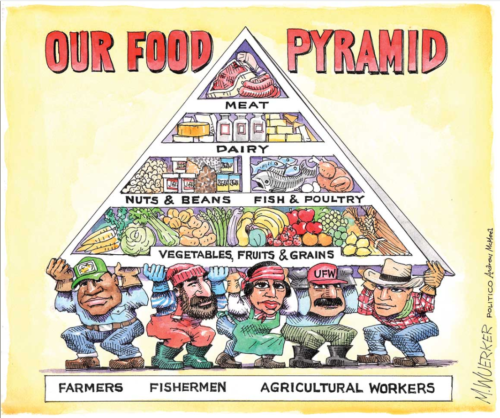

I saw this in a tweet from the Politico cartoonist, Matt Wuerker. It’s too good not to share.

The White House issued a fact sheet on promoting competition in several business areas, one of them agriculture.
Over the past few decades, key agricultural markets have become more concentrated and less competitive. The markets for seeds, equipment, feed, and fertilizer are now dominated by just a few large companies, meaning family farmers and ranchers now have to pay more for these inputs. For example, just four companies control most of the world’s seeds, and corn seed prices have gone up as much as 30% annually. Consolidation also limits farmers’ and ranchers’ options for selling their products. That means they get less when they sell their produce and meat—even as prices rise at the grocery store…Overall, farmers’ and ranchers’ share of each dollar spent on food has been declining for decades. In short, family farmers and ranchers are getting less, consumers are paying more, and the big conglomerates in the middle are taking the difference.
In the Order, the President:
The rules seek to make it easier for the agency to challenge unfair and deceptive practices by meat processors and would allow farmers to more easily file complaints with USDA or sue under the Packers and Stockyards Act. People familiar with the order said it would also tighten the rules for so-called poultry grower tournament systems, in which contract farmers are paid more or less than their peers in the same area depending on how closely they meet buyers’ standards.
The agency is also moving forward with rules that seek to increase food access through alternatives to supermarkets, like local farmer’s markets, and increase consumer transparency about where meat is raised.
Lest anyone think these are trivial measures, take a look at the reactions.
The North American Meat Institute:
President Biden’s executive order calling for USDA to change the Packers and Stockyards rules will have unintended consequences for consumers and producers…Government intervention in the market will increase the cost of food for consumers at a time when many are still suffering from the economic consequences of the pandemic. These proposed changes will open the floodgates for litigation that will ultimately limit livestock producers’ ability to market their livestock as they choose. These proposals have been considered and rejected before and they are counter to the precedent set in eight federal appellate circuits.
Zephyr Teachout in The Nation:
He ordered the Department of Agriculture to use its full power under the Packer and Stockyards Act to break the stranglehold of distributors and other corporate giants that crush farmers and farmworkers…Biden has a chance to be the first trust-busting presidency in over 50 years—and we keep getting strong signals that he’s got it in his sights. That’s great news for workers, for small businesses, and for the small communities that have been left out in the collapsing concentration of our country for the last 50 years.
USDA Vilsack announces plans to boost competition:
Secretary Tom Vilsack said USDA will offer $500 million in grants, loans, and other assistance to help new meat and poultry processors enter the market, along with $150 million to support small plants that are already operating. The department will also move forward with a series of regulations to protect farmers and ranchers who work with large agribusinesses.
The National Sustainable Agriculture Coalition applauds Vilsack’s action:
NSAC is also pleased to see that USDA will issue new rules under the Packers and Stockyards Act. As directed in the Executive Order, this new rule will make it easier for farmers to bring and win claims, stopping chicken processors from exploiting and underpaying chicken farmers, and adopting anti-retaliation protections for farmers who speak out about bad practices.
Will Biden’s USDA follow through? That would be real progress.
Yesterday, I posted information about the forthcoming UN Summit on Food Systems (UNFSS) and its Pre-Summit. The Summit has been heavily criticized on the grounds that it:
These criticisms are so severe that The Civil Society and Indigenous Peoples’ Mechanism for Relations with the UN (CSM) is organizing counter events July 25 to July 27.
Much has been written to document such concerns.
Civil Society and Indigenous Peoples Mechanism, North America: UN Food System Summit “Dialogue” events spark renewed concerns of corporate capture in North American food system and rural economies globally
In March 2020, 550 civil society organizations sent an open letter to the United Nations (UN) Secretary-General condemning the involvement of the World Economic Forum in the UNFSS, the appointment of Ms. Agnes Kalibata as UNFSS Special Envoy due to her links to corporate agribusiness, the failure of the UNFSS to elevate the primacy and indivisibility of human rights frameworks as foundational to the governance of food systems, and the necessity of civil society organizations to have an autonomous, self-organized, and equal ‘seat at the table.’ These concerns have not been addressed despite numerous CSM interactions with UNFSS organizers.
The International Panel of Experts on Sustainable Food Systems (IPES): An IPCC [Intergovernmental Panel on Climate Change] for Food?” How the UN Food Systems Summit is being used to advance a problematic new science-policy agenda.
Behind what sounds like a technocratic question is in fact a high-stakes battle over different visions of what constitutes legitimate science and relevant knowledge for food systems. This, in turn, is part of a broader battle over what food systems should look like and who should govern them.
Matthew Canfield, Molly D. Anderson and Philip McMichael. UN Food Systems Summit 2021: Dismantling Democracy and Resetting Corporate Control of Food Systems. Front. Sustain. Food Syst., 13 April 2021. [Note: this paper has an especially useful historical account of attempts to establish global food system governance]
Although few people will dispute that global food systems need transformation, it has become clear that the Summit is instead an effort by a powerful alliance of multinational corporations, philanthropies, and export-oriented countries to subvert multilateral institutions of food governance and capture the global narrative of “food systems transformation”…It elaborates how the current structure and forms of participant recruitment and public engagement lack basic transparency and accountability, fail to address significant conflicts of interest, and ignore human rights.
Independent scientists: Open letter to policy makers: No new science-policy interface for food systems.
We call on governments and policymakers to…Support participatory processes that actively and meaningfully include plural perspectives and voices in food system governance. Farmers and other citizens need inclusive, participatory, and safe spaces within the CFS-HLPE process to co-create the knowledge necessary to govern food systems at global, national and local levels.
Maywa Montenegro, Matthew Canfield, and Alastair Iles. Weaponizing Science in Global Food Policy.
Nobody disputes the need for urgent action to transform the food system. But the UNFSS has been criticized by human rights experts for its top-down and non-transparent organization. Indigenous peoples, peasants, and civil society groups around the world know their hard-won rights are under attack. Many are protesting the summit’s legitimacy and organizing counter-mobilizations.
Scientists are also contesting a summit because of its selective embrace of science, as seen in a boycott letter signed by nearly 300 academics, from Brazil to Italy to Japan.
Through the Summit, “science” has been weaponized by powerful actors not only to promote a technology-driven approach to food systems, but also to fragment global food security governance and create institutions more amenable to the demands of agribusiness.
Scientists: An open letter from scientists calling for a boycott of the 2021 Food Systems Summit.
Some critics of the UNFSS have suggested ways that the process could become less problematic: (1) it could incorporate a human rights framing into all of its “action tracks”; (2) it could create an action track led by the CSM on the corporate capture of food systems; and (3) it could designate the UN Committee on World Food Security as the institutional home to implement recommendations coming out of the summit.
Nisbett N, et al. Equity and expertise in the UN Food Systems Summit. BMJ Global Health. 2021;6:e006569.
…time is not late to take action in rebalancing powers and enabling a greater diversity of knowledge, not simply among a multiplicity of voices in multiple public forums, but explicitly engaged at the summit’s top table of expertise and summit leadership. It is also not late to adopt mechanisms that limit the engagement of those actors whose primary interests have driven our food systems to
become unhealthy, unsustainable and inequitable, so the voices of the people can be clearly heard..
An alternative: The Global People’s Summit on Food Systems
The People’s Summit is composed primarily of movements of landless peasants, agricultural workers, fisherfolk, indigenous people, rural women, and youth—or small food producers who produce 70% of the world’s food, yet remain among the world’s poorest and food insecure. “The issue of landlessness and land grabbing is not on the agenda of the UNFSS. Nowhere in its so-called Action Tracks do discussions highlight critical trends such as on land concentration and reconcentration in the hands of big agribusiness firms and their network of local landlords and compradors, nor on the massive displacement of rural communities to give way to big private investments and large development projects,” said Chennaiah Poguri, chairperson of the Asian Peasant Coalition (APC).
Additions
A notice to journalists reminds me that it’s time to talk about the UN Summit on Food Systems, scheduled for September. The notice is about the forthcoming Pre-Summit in Rome:
WHEN: The Pre-Summit will take place from Monday, July 26 to Wednesday, July 28.
The tentative programme is available online and virtual media briefings will take place daily. To be able to attend, journalists can register for accreditation here.
WHERE: The Food Systems Pre-Summit is being held in Rome under the leadership of the UN Secretary-General and in partnership with the Government of Italy. A series of affiliated events will take place alongside the Pre-Summit.
WHO: A few of the high-level speakers and delegates expected to participate include:
- Mario Draghi, Prime Minister of Italy
- Katrin Jakobsdottir, Prime Minister of Iceland
- António Guterres, UN Secretary-General
- Amina Mohammed, UN Deputy Secretary-General
- Agnes Kalibata, UN Secretary-General’s Special Envoy for the 2021 Food Systems Summit
- María Juliana Ruiz, First Lady of Colombia
WHY: Ahead of the UN Food Systems Summit, which will take place in September 2021 in New York, the three-day gathering aims to deliver the latest evidence-based and scientific approaches from around the world, launch a set of new commitments through coalitions of action and mobilize new financing and partnerships.
The event will bring together youth, farmers, Indigenous Peoples, civil society, researchers, the private sector, policy leaders and ministers of agriculture, environment, health, nutrition and finance, among other players. More than 70 ministers and commissioners of Member States and the EU are confirmed to participate.
Previous UN press releases explain the preparation for the Pre-Summit and the Summit itself.
January 27: The five action tracks
April 26: More than 100 countries sign on to develop ways to transform food systems to meet the Sustainable Development Goals.
June 9: the UN announces the results of more than 100 Independent Dialogues on food system transformation.
Independent Dialogues, convened by any interested group on any topic, are one of three main components of the Summit Dialogues along with government-led Member State Dialogues and thematic Global Dialogues. More than 10,000 people took part in the independent sessions that submitted feedback to the Summit by the end of May. Among the 10 common themes that emerged in a new synthesis report published today were diversity, equity, transparency, the need to shift perspectives, and the need to adapt solutions to local contexts.
June 25: the UN announces solutions to problems of food system transformation:
The solutions, published on the online Summit Community, are an extensive menu of possible actions expected to support Member States as they work through national pathways for food systems transformation…The solutions were refined from more than 2,000 ideas proposed during 18 months of dialogues, surveys and open fora with Indigenous Peoples, youth, producers, researchers, NGOs and governments, and represent key areas to address some of the world’s most pressing issues, from hunger and poverty to climate change. Among the game-changing solutions are initiatives to reimagine school meals programmes as well as proposals to include the cost of a healthy diet when calculating poverty lines.
The UN has also issued position papers defining:
And it has an FAQ on the Summit.
All of this sounds thrilling, useful, and much needed, but is it? What’s really going on here?
Tomorrow: The critique—Corporate control of the Summit agenda.
Lots of people take supplements in the hope that they will help with body weight. This is a big market. Drug companies want in on it. Most drugs don’t work, or have deal-breaking side effects. In June, The FDA approved Novo Nordisk’s Semaglutide for obesity management.
I subscribe to the Obesity and Energetics newsletter, which sends out weekly lists of research, articles, and commentary on those topics—a great way to stay up on current literature.
On July 2, it featured:
This referred to: Perspective: Dietary supplements and alternative therapies for obesity: A Perspective from The Obesity Society’s Clinical Committee. Srividya Kidambi, John A. Batsis, William T. Donahoo, Ania M. Jastreboff, Scott Kahan, Katherine H. Saunders, Steven B. Heymsfield. Obesity 23 June 2021.
Our recommendation to clinicians is to consider the lack of evidence for non-FDA-approved dietary supplements and therapies and guide their patients toward tested weight management approaches…we call on regulatory authorities to critically examine the dietary supplement industry, including their role in promoting misleading claims and marketing products that have the potential to harm patients.
I am with the Obesity Society on this one, but what caught my interest was that several of the authors report financial tied to drug companies with interests in pharmacologic approaches to obesity treatment.
Conflicts of interest: SK serves as Medical Editor for TOPS Magazine (TOPS Inc. nonprofit weight loss club) and as Director for the TOPS Center for Metabolic Research at the Medical College of Wisconsin supported by TOPS Inc. JAB’s research reported in this publication was supported in part by the National Institute on Aging of the National Institutes of Health (NIH) under Award Number K23AG051681. JAB reports equity in SynchroHealth LLC. AMJ’s research is supported by the NIH/NIDDK, the American Diabetes Association, Novo Nordisk, and Eli Lilly; she serves as a consultant for Novo Nordisk, Eli Lilly, and Boehringer Ingelheim. SKa has served as a consultant for Novo Nordisk, Vivus, Gelesis, and Pfizer. KHS reports an ownership interest in Intellihealth. SBH reports his position on the Medical Advisory Board of Medifast Corp.
The newsletter also featured the article referred to in the Perspective.
When I clicked on this link, it took me to the page where I could download the pdf. I got the paper at this site. But before I could read it, I had to see an ad for Novo Nordisk’s drug, Semaglutide. Then I scrolled down to get the study: A Systematic Review of Dietary Supplements and Alternative Therapies for Weight Loss. John A. Batsis, John W. Apolzan, Pamela J. Bagley, Heather B. Blunt, Vidita Divan, Sonia Gill, Angela Golden, Shalini Gundumraj, Steven B. Heymsfield, Scott Kahan, Katherine Kopatsis … Obesity (2021) 29, 1102-1113
Study conclusion: “There is weak evidence for the efficacy of dietary supplements and alternative therapies.”
Authors’ disclosure: JAB reports equity in SynchroHealth LLC. AG reports consulting with Novo Nordisk and Unjury. SH reports personal fees from Medifast. SKa reports personal fees from Novo Nordisk, Pfizer, Vivus, and Gelesis. DR reports consulting and speaking fees for Novo Nordisk and Astra Zeneca. KHS has a relationship with Intellihealth Inc. SK is the medical director for TOPS Center for Metabolic Health at the Medical College of Wisconsin, which is supported by TOPS Inc. SBH reports his position on the Medical Advisory Board of Medifast Corp.
I much prefer dietary approaches to weight management and policy strategies to make healthy diets the easy choice.
I am almost never in favor of supplements. The evidence that they do much beyond placebo effects is usually pretty weak.
The ad gives the side effects for Semiglutide; it has to.
My point: all of this seems to be about marketing Semiglutide.
The Pan-American Health Organization (PAHO) has developed a Nutrient Profile Model, which it describes as “a tool to classify processed and ultra-processed food and drink products that are in excess of critical nutrients such as sugars, sodium, total fat, saturated fat and trans-fatty acids.”
To understand how it works, go to the website. Watch the video.
Its purpose, as explained in the print publication is to help governments to identify unhealthy products and use public policies to discourage the consumption of those products.
The Expert Consultation Group described in this report was commissioned to develop a Nutrient Profile Model for the Pan American Health Organization – the PAHO NP Model – to be used as a tool in
the design and implementation of various regulatory strategies related to the prevention and control of obesity/overweight, including the following:
• Restriction in the marketing of unhealthy food and beverages to children
• Regulation of school food environments (feeding programs and food and beverages sold in schools)
• Use of front-of-package (FOP) warning labels
• Definition of taxation policies to limit consumption of unhealthy food
• Assessment of agricultural subsidies
• Identification of foods to be provided by social programs to vulnerable groups.
The criteria for ultra-processed foods to be avoided or eaten in small amounts:
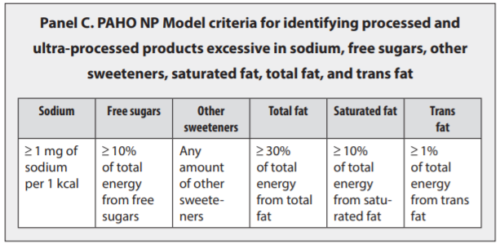
It’s a start.
PAHO produces its Nutrient Profile Tool in Spanish, of course: Perfil de Nutrientes – OPS/OMS | Organización Panamericana de la Salud (paho.org)a
It also has a report listing ultra-processed foods in Latin America, and many other useful documents.
As for me, I rather like the broader definition of ultra-processed foods described by the Brazilian public health academics who defined the term:
A practical way to identify an ultra-processed product is to check to see if its list of ingredients contain…either food substances never or rarely used in kitchens (such as high-fructose corn syrup, hydrogenated or interesterified oils, and hydrolysed proteins), or classes of additives designed to make the final product palatable or more appealing (such as flavours, flavour enhancers, colours, emulsifiers, emulsifying salts, sweeteners, thickeners, and anti-foaming, bulking, carbonating, foaming, gelling and glazing agents).
All of these are great resources for food policy in Latin America.
Let’s hope governments respond.
The Rudd Center at the University of Connecticut issued a press release for its latest report on fast food marketing:
The fast-food industry spent $5 billion on advertising in 2019, and the advertisements disproportionately targeted Black and Latino youth, according to new research published today by the Rudd Center for Food Policy and Obesity at the University of Connecticut. The new report, Fast Food FACTS 2021, finds that the industry’s annual ad spending in 2019 increased by over $400 million since 2012, and that children and teens were viewing on average more than two fast food TV ads per day.
The report provides details on spending amounts.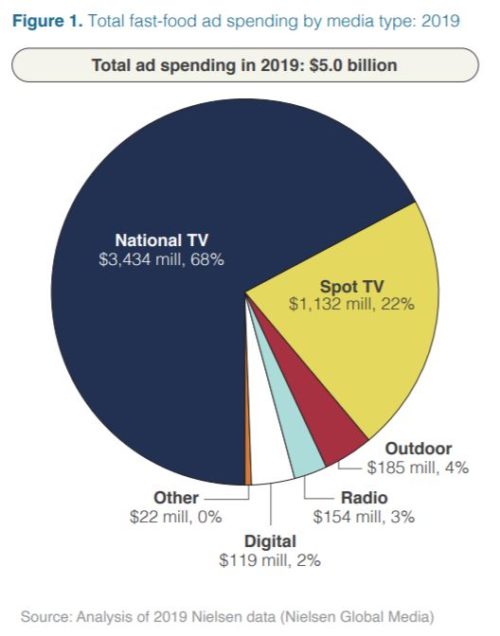
It also breaks spending down by target:
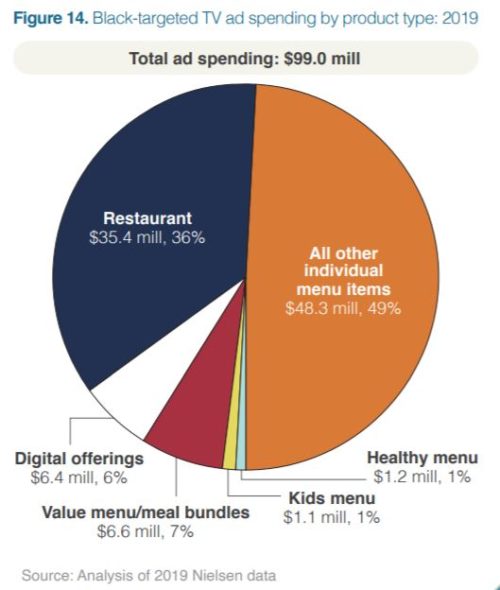
And it gives many examples of the ways fast food companies market to kids:
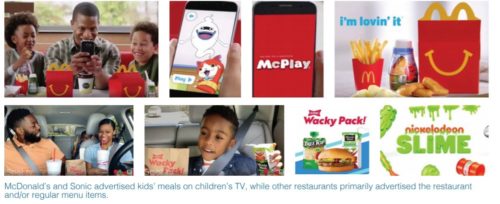
Isn’t it time to put a stop to this?
The report offers suggestions for voluntary actions, but that seems like a waste of time; companies are not going to voluntarily stop marketing to kids. Way too much money is involved.
The Rudd Center also has lots of recommendations.
I’d start with this one:
The U.S. federal government should eliminate unhealthy food and beverage marketing to children as a tax-deductible corporate expense.
As I mentioned yesterday, everyone seems to be doing reports on food systems—a deluge. Here are the most recent ones I’ve collected.
Food and Water Watch: Well-Fed: A Roadmap To A Sustainable Food System That Works For All
The report outlines the alarming degree of corporate consolidation in the food industry and its impact on consumers and small farms. For example:
Global Alliance for the Future of Food: Beacons of Hope: Stories of Food Systems Transformation During COVID-19
Building on a program of work launched in 2019 — “Beacons of Hope: Stories of
Transformation” — this short report shares stories of food systems initiatives and the
people who responded to the COVID-19 pandemic with creativity, adaptability, and resilience.
Global Alliance for the Future of Food: How to Transform Food Systems: 7 Calls to Action
The Global Alliance advocates for increased systems-based research into the future of food and positive food environments that are adapted to meet regional conditions and cultural contexts. We also call for transformed governance and decision-making, with additional investment and support for agroecology and regenerative approaches, and excluding harmful subsidies and incentives.
World Resources Institute: Food Systems at Risk: Transformative Adaptation for Long-Term Food Security
Food security, people, climate. These three words are inextricably linked; changes to one will inevitably affect the others. As climate change threatens food-producing regions, what changes are needed to feed a growing population? How can we shift food systems to better adapt to the changing climate? More explicitly, how can policymakers help hundreds of millions of small-scale agricultural producers to enhance food security and improve livelihoods despite the challenges that climate change brings?
OECD (Organisation for Economic Co-operation and Development): Agricultural Policy Monitoring and Evaluation 2021: Addressing the Challenges Facing Food Systems
This annual report monitors and evaluates agricultural policies in 54 countries, including the 38 OECD countries, the five non-OECD EU Member States, and 11 emerging economies. The report includes country specific analysis based on up-to-date estimates of support to agriculture that are compiled using a comprehensive system of measurement and classification – the Producer and Consumer Support Estimates (PSE and CSE) and related indicators. This year’s report focuses on policy responses to the COVID-19 pandemic and analyses the implications of agricultural support policies for the performance of food systems.
FAO (Food and Agriculture Organization of the UN): Food Systems and Nutrition: Handbook for Parliamentarians
Parliamentary action is fundamental to securing the right to adequate food for all. Parliamentarians guide and oversee public-sector policies and budget allocations towards transforming food systems that deliver healthy diets for all. Our vision for this handbook is to provide parliamentarians with practical guidance
to support legislative processes that prioritize nutrition. We look forward to promoting this handbook – together with governments, other international organizations, civil society and other stakeholders – as a tool to facilitate efforts that will accelerate progress towards the SDGs. [Sustainable Development Goals].
Committee on World Food Security (CFS)‘s High Level Panel of Experts (HLPE) on Food Security and Nutrition: Promoting Youth Engagement and Employment in Agriculture and Food Systems
A new UN report on youth and agriculture underscores the urgent need to make agri-food systems more appealing to young people to secure the future of global food security and nutrition. The panel provides independent, scientific analyses and advice to the CFS, an inclusive international and intergovernmental platform for all stakeholders to work together on food security and nutrition for all.